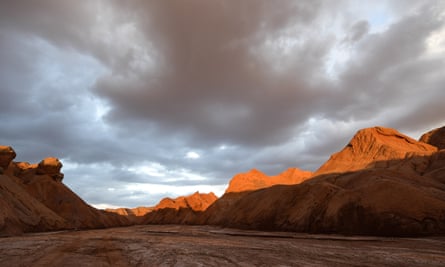The 55m-kilometre jaunt from planet Earth to the red planet takes up to a year. From Beijing’s international airport you’ll soon be able to fly there in just over seven hours.
In the latest leg of its multi-billion dollar race for space, China has unveiled plans to build a 400m yuan (£47m) replica of Mars on a spectacular, sandswept corner of the Tibetan plateau.
The “simulated Mars station” – a 95,000 square-kilometre tribute to the solar system’s second-smallest planet – will be built in Qinghai province’s Haixi Mongolian and Tibetan autonomous prefecture, not far from the westernmost tip of the Great Wall.
Xinhua, China’s official news agency, described the breathtaking red rock location as “the most Martian place on Earth”.
Liu Xiaoqun, a space exploration expert from the Chinese Academy of Sciences who is leading the attempt to recreate Mars on Earth, declined to speak to the Guardian about the project. “Liu Xiaoqun isn’t in Beijing and he doesn’t want to take any interviews,” said Huang Jingyi, a press officer from the state-run academy.
But local reports suggest the remote desert base will be used for a mix of serious space research and money-spinning glamping of the sort that is becoming increasingly popular among well-off Chinese.
One section of the “hyper-arid” high-altitude camp will be used to train Chinese astronauts, state broadcaster CCTV reported earlier this summer. Another part will receive tourists hungering for a taste of life on Mars. “People dream about migrating to Mars, so what we want to do is give people a high-end experience of what it would actually be like to live in outer space,” Liu said, according to the South China Morning Post.

Xinhua said adventure-seeking glampers would be housed on a “Mars campside” featuring “module-like accommodations” designed to simulate extraterrestrial living. A Mars-themed amusement park will also be created. CCTV said guests would “find out what life on Mars is really like” by experiencing weightlessness and hiking in the area’s arid desert terrain. Despite its isolated location, the campsite is likely to be rather more hospitable than Mars, which has an unbreathable atmosphere that contains only 0.2% oxygen.
Zhang Biao, the deputy mayor of Delingha, the nearest city to China’s Mars, said the project would boost the local economy as well as awareness of Beijing’s space program. “The building of the Mars village has both scientific and ecological significance,” he told Xinhua.
China is fighting to transform itself into a space superpower, as part of a wider bid for international prestige that has accelerated since Xi Jinping took power in 2012. Beijing hopes to have a permanent manned space station operating by 2022 and to send a probe to the real Mars in 2019. In 2013 China became the first country to soft land on the moon in almost four decades as part of efforts to send the first Chinese astronaut there.
Not everyone is convinced that Qinghai’s Mars simulation base will help China’s space ambitions. Jiao Weixin, a Peking University scholar, suggested it was more gimmick than game-changer. “It will be difficult for the Mars simulation to imitate the original,” he was quoted as saying by the Global Times newspaper.
Additional reporting by Wang Zhen
